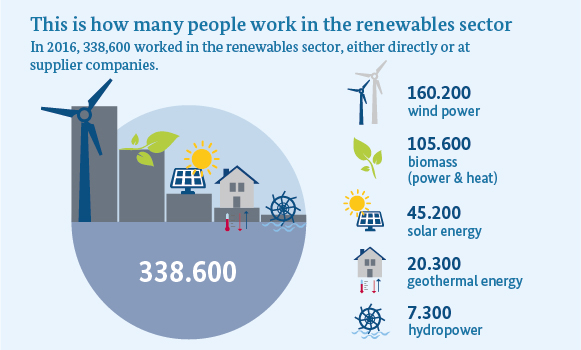Employment continues to grow in the renewables sector
In 2016, 338,600 people worked in the renewable energy sector in Germany. That is 10,000 more than in the previous year. Wind power accounted for most of the new jobs.
 © Federal Ministry for Economic Affairs and Energy; data based on DIW Berlin, DLR and GWS
© Federal Ministry for Economic Affairs and Energy; data based on DIW Berlin, DLR and GWS
Employment in the renewables sector continues to grow: in 2016, 338,600 people worked in renewable energy in Germany. That is 10,000 more than in the previous year and and a threefold increase since the year 2000, when only 106,700 people worked in the renewables sector. These figures are based on a study commissioned by the Federal Ministry for Economic Affairs and Energy on the key economic indicators of energy supply. The study can be downloaded here (in German only).
Wind power is driving job creation
With 160,200 jobs, almost half of the people who work in the renewables sector work in wind power. Onshore and offshore wind power account for 133,000 and 27,200 jobs respectively. Some 105,600 people work in the biomass sector, and 45,200 in solar energy.
The study covers not only persons who are directly involved in operating and maintaining renewable energy installations, but also the employees working for companies that produce renewables installations or components such as wind turbine blades.
The energy sector is undergoing fundamental structural change
The study shows that the number of employees working in key areas of the energy sector such as energy supply and trading has remained relatively stable over the last few years. At the same time, the structural change caused by the energy transition also becomes clear: Germany is moving away from conventional sources of energy – such as hard coal – and towards renewables.
Whilst in the year 2000, more than 100,000 people worked in the hard coal sector, this number fell to around 100,000 in 2016.
Some sources of renewable energy, for example photovoltaics, are also undergoing structural change: the number of employees working in this sector peaked in 2011 (at 150,000), but has since fallen to around a third of this figure. This is because competition in this sector has become a lot fiercer over the years, with most of photovoltaics installations now being produced outside Germany. In contrast to this, jobs in wind power have continued to grow over the last few years: since 2011, almost 100,000 new jobs have been created in this sector.
Economic impact of the energy sector
The study is based on data from publications issued by the Federal Statistical Office, particularly on conventional energy sources, and on the Federal Ministry for Economic Affairs and Energy’s own calculations and estimates, particularly on renewable energy. The study not only looks at employment figures, but also analyses the overall economic impact that the energy sector has by looking at production output, investment and jobs. Renewable and conventional sources of energy are equally taken into account.

